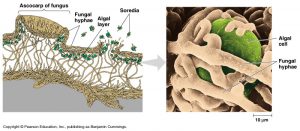My microorganism, is a lichen a mutualistic organism of fungus and algae. While it may live in most areas Lichens do need a specific environment to survive. Algae alone don’t have a waxy cuticle like plants, so they are unable to retain water during drought periods that was until the introduction of fungal hyphae into the system allowing them to absorb liquid water and water vapor. When Lichens are wet or in a moist area they are on and photosynthesizing and actively growing while when they are dry are turned off. This is known as poikilohydry allowing lichen to turn off its photosensitive machinery and conserve energy. You can tell if a lichen is in the on form based on its color.
Lichen also needs clean air to exist and survive. In the industrial age specifically being sensitive to Sulfur dioxide which can quickly degrade the fungal thallus of the lichen. Notice how most cities don’t have lichen (or at the very least a less diverse amount of lichen) just algae on the trees at best. This can make lichen a great indicator of pollution. For example bushy lichen needs cleaner air, leafy can survive a little bit of pollution while crusty lichen (like Canoparmelia texana ) can survive air pollution.
Like all living things lichen needs nutrients to exist like O2, CO2, H2O and especially nitrogen. While Lichen needs nitrogen, it can’t normally access it in its current state so that where other microorganisms step in like the to make it usable. The cyanobacteria in the lichen can be used to fix the nitrogen so it can be actively used by the lichen. Other than that CO2 and O2 are obtained through other normal algal functions
Finally, is the physical location lichen lives or the substrate. Many lichens can grow on rocks trees and the soil itself. This combined with its as poikilohydry abilities allows it to grow and survive in multiple diverse locations and even change the habitat such as sand dunes allowing other species to colonize the area. The Shield Lichen I found was located on top the trees of Arabian mountain and can be found throughout the









